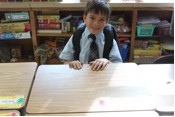 With each Megazord tower, my son stacked a primary-colored Duplo brick on top of another with precision. Like a skilled mason, he took pride in his craft and carefully secured each brick, committing to make each tower taller than the last. But when it reached its summit and couldn’t withstand the weight and pressure of the blocks, the tower toppled. And every time, just like the last, we’d laugh and start all over.
With each Megazord tower, my son stacked a primary-colored Duplo brick on top of another with precision. Like a skilled mason, he took pride in his craft and carefully secured each brick, committing to make each tower taller than the last. But when it reached its summit and couldn’t withstand the weight and pressure of the blocks, the tower toppled. And every time, just like the last, we’d laugh and start all over.
We made countless amounts of Megazord towers over the past year. In fact, it was a year of towers and then some. We finally built up our patience and tested his 5-year-old endurance by playing a marathon Monopoly game. We completed puzzles, built train tracks, played a whole lot of video games, and of course, spent hours and hours outside riding a tire swing and playing rugby. We played a lot because it’s what 5-year-olds do.
After years of research, reluctance, and emotional struggle, last year we redshirted Kindergarten for Jack. It was one of the most difficult decisions we had ever made as parents, and as he starts Kindergarten this year, I am breathing a sigh of relief.
Because of his late September birthday, just four days from the October 1st cutoff, instead of sending him to Kindergarten “on time”, we opted to enroll Jack in Transitional Kindergarten at our Catholic school. Transitional Kindergarten, unlike any preschool program, allows students like ours—too young for Kindergarten, but too old for pre-K—to grow another year through play while interacting in a formal school setting.
After a few weeks in Transitional Kindergarten, the smiles and burgeoning new skills overshadowed that difficult decision and soon validated it to be the best decision. In the various articles I read about redshirting Kindergarteners, I read that most kids aren’t ready for “real” school at 4. Last fall, I knew that was the case for my kid. We had just endured a summer of relentless hospital stays: we watched my husband suffer from anaphylaxis and get whisked away in an ambulance and just months later learned that baby brother was diagnosed with epilepsy. As strong as my big guy is, all of that took its toll. Separation anxiety and nightmares compounded by typical 4-year-old fears of the unknown plagued my big boy. Despite his “big” size and maturity level, it was clear that Jack was not ready for Kindergarten.
Throughout his year in Transitional Kindergarten, Jack would develop lifelong friendships with other late-in-year-birthday friends. In addition to learning to read and sharpening math skills, above all else, the kids would play. They played during recess, they played after storytime, and they often played when they learned. In an overstructured and stringent society where our educational systems emphasize standardized tests and we schedule playdates just so our kids can play together, I feel comfortable with our decision.
There’s much to be said about playing. As the country teeters on the idea and politics behind universal preschool, it’s safe to say, I’m a huge advocate of accessibility to quality education, especially if it involves play. As The Chronicle of Higher Education stated in its 2011 article “The Case for Play”, researchers say that play matters not only because play reduces stress and makes children more socially competent, but it also matters “because play supposedly improves working memory and self-regulation. In other words, it makes kids sharper and better-behaved.” The article goes on to say, by shortchanging kids of play in favor of academics, we may be inhibiting their development.
California recently introduced Transitional Kindergarten as a statewide effort, describing it as a new grade for children who just missed the cutoff. In a timely article I read about California’s new grade, I found a quote that made so much sense and rang so true for our current situation: “Kindergarten teachers have gotten rid of the blocks and the dress-up corner and transitional kindergarten classrooms have the opportunity to bring those back.” But, “it requires some resources.”
Even though I often find myself explaining Transitional Kindergarten to anyone who asks, I’m glad to know California is forging ahead and perhaps giving us a glimpse of universal preschool. I may not be a child development specialist or educator, but as a mother, I trust my instincts enough to know that growth and play go hand in hand when it comes to my child. I’ll be forever grateful that Transitional Kindergarten bridged a gap of growth and gave our 5-year-old an extra year to find a love of learning.
Like most parents, I often ask my 5-year-old what his favorite part of school was that day. “Building the biggest tower/castle/Megazord with my friends!” he’ll say.
While reading, writing, and arithmetic are the foundation from which we build upon, making the motion for play ranks pretty high up there, too.

